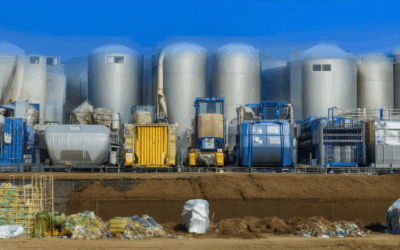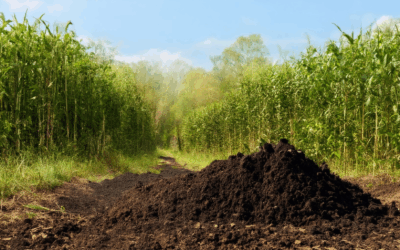In the ever-evolving landscape of environmental solutions, biochar for environmental remediation stands out as a groundbreaking approach. Derived from organic materials through a process called pyrolysis, biochar emerges as a carbon-rich substance that not only enhances soil health but also plays a pivotal role in carbon sequestration. This unique characteristic positions biochar as a key player in sustainable practices, resonating deeply with global efforts aimed at combating climate change. As industries increasingly seek eco-friendly alternatives, biochar’s versatility and effectiveness make it a versatile tool for addressing a wide array of environmental challenges, from soil contamination to water purification. With its dual benefits of improving soil quality and reducing greenhouse gas emissions, biochar is poised to revolutionize environmental remediation strategies.
Key Takeaways
– Applying Biochar Effectively
– Choose biochar from high-quality organic sources suited to your soil’s specific needs.
– Apply biochar at the correct rate, considering factors like soil type and intended use to optimize benefits.
– Incorporate biochar into the soil correctly to maximize its effectiveness and accessibility for plants and beneficial microorganisms.
- Biochar’s Multipurpose Potential
- Biochar effectively captures CO2, offering a sustainable solution for carbon sequestration and combating climate change.
- It enhances soil structure and fertility, potentially increasing crop yields by up to 20%.
- Biochar transforms organic waste into a valuable resource, reducing reliance on landfills and lowering methane emissions.
- It absorbs and immobilizes heavy metals, making contaminated soils viable for agriculture.
- Biochar filters impurities and heavy metals from water, improving wastewater treatment and ecosystem health.
- Environmental Benefits of Biochar
- Improves soil health and fertility, supporting sustainable farming practices.
- Enhances soil water retention, reducing runoff and enhancing drought resistance.
- Acts as a powerful carbon sink, helping to reduce greenhouse gas emissions.
- Traps pollutants like NOx and ammonia, contributing to better air quality.
- Promotes sustainable waste management by converting organic waste into a valuable resource.

Downsides of Biochar
Biochar, while offering numerous benefits, also presents several potential downsides:
- Environmental Emissions:** During the production process, biochar creation can release carbon dioxide (CO2) and volatile organic compounds (VOCs), contributing to air pollution unless the facility is equipped with advanced emission control systems.
- Toxin Presence:** Biochar may contain harmful substances such as dioxins, furans, and polycyclic aromatic hydrocarbons (PAHs), which can pose risks to human health and the environment if not properly filtered or managed.
- Carbon Sink Diversion:** While effective at sequestering carbon, biochar production diverts organic waste that could otherwise be managed differently, potentially affecting broader waste management strategies.
- Energy Requirements:** The energy-intensive nature of biochar production can strain local resources, particularly if not sourced sustainably or powered by renewable energy.
- Economic Barriers:** High initial costs and scalability challenges can hinder widespread adoption, especially in regions with limited infrastructure or financial resources.
- Disposal Challenges:** Improper disposal of biochar can lead to clogged sewers and water systems, necessitating careful management to avoid sanitation issues.
How Does Biochar Help the Environment?
Biochar is a versatile material produced through the pyrolysis of organic waste, offering significant environmental benefits. Here’s a breakdown of its positive impact:
- Carbon Sequestration: Biochar acts as a carbon sink, capturing and storing carbon dioxide from the atmosphere. This reduces greenhouse gas levels and contributes to combating climate change.
- Soil Health Improvement: By adding biochar to soil, it enhances water infiltration, improves nutrient retention, and increases soil fertility. This reduces the need for synthetic fertilizers and pesticides, promoting sustainable agriculture.
- Reduced Greenhouse Gas Emissions: Biochar amendments can decrease emissions of methane and nitrous oxide, two potent greenhouse gases released from decomposing organic waste in landfills and agricultural soils.
- Waste Management: Converting organic waste into biochar diverts it from landfills, where it would otherwise produce methane, and repurposes it for various applications, supporting a circular economy.
- Agricultural Resilience: Biochar improves soil structure, making it more resistant to erosion and capable of holding water better during droughts. This supports food security and agricultural sustainability.
Biochar’s versatility extends beyond agriculture, with applications in carbon capture projects and renewable energy production. Its production process, pyrolysis, efficiently converts biomass into biochar while generating energy, making it a clean and sustainable alternative.
By incorporating biochar into farming practices and waste management systems, individuals and industries can contribute meaningfully to environmental sustainability and combat global challenges effectively.

What is Biochar in Remediation?
Biochar is a carbon-rich material derived from the pyrolysis of organic waste, playing a significant role in soil remediation processes. It acts as an effective amendment in addressing heavy metal contamination in soil.
Mechanisms of Action
- Adsorption: Biochar binds to heavy metals, reducing their mobility and availability for plant uptake.
- Precipitation: Metals form stable compounds with biochar, immobilizing them in the soil matrix.
- Soil Property Alteration: Biochar modifies soil pH and structure, affecting metal speciation and bioavailability.
Applications in Soil Remediation
Biochar is applied to contaminated soils to immobilize metals, thereby reducing their risk to ecosystems. Its application is particularly beneficial in areas with high levels of pollutants like lead, zinc, and cadmium.
Comparison with Other Carbon Amendments
While biochar is highly effective, it is often compared to other carbon-based amendments like activated carbon. However, biochar stands out due to its cost-effectiveness and ability to promote long-term soil health improvements.
Considerations and Future Directions
When implementing biochar remediation, factors such as contamination type and soil conditions must be considered. Research continues to explore its efficacy in various scenarios, ensuring optimal use in different contexts.
For deeper insights into biochar production and application, visit our guide on biochar production .

Understanding the 3R Principles for Applying Biochar
The 3R principles for applying biochar effectively to enhance soil health are essential for achieving optimal results. These principles guide users in selecting the right biochar, applying it at the correct rate, and placing it appropriately in the soil.
- Right Biochar Source: Select biochar produced from high-quality organic feedstocks. Different feedstocks yield biochars with varied nutrient compositions and properties. Choose based on your soil’s needs and the specific benefits you aim to achieve.
- Right Application Rate: Apply biochar at the recommended rate, which varies depending on factors like soil type, climate, and intended use. Over-application can lead to inefficiencies, while under-application may provide insufficient benefits.
- Right Placement: Incorporate biochar into the soil at the appropriate depth and distribution. Proper placement ensures that biochar remains accessible to beneficial soil organisms and plants, maximizing its effectiveness.
By adhering to these principles, you can maximize biochar’s benefits, including improved soil structure, increased nutrient availability, and enhanced carbon sequestration. Always consider soil testing and local conditions before application to ensure optimal results.
How Biochar Is An Environment-Friendly Alternative For Multiple Applications
Biochar, produced through a controlled pyrolysis process, offers a sustainable and versatile solution for various environmental challenges. Its unique properties make it highly effective in multiple applications, positioning it as a cutting-edge eco-friendly alternative.
1. Carbon Sequestration
Biochar plays a pivotal role in carbon sequestration, capturing and storing carbon dioxide (CO2) from the atmosphere. Unlike traditional carbon sinks, biochar can lock away carbon for centuries, contributing to carbon-negative strategies. Studies show that biochar can sequester up to 4 times more CO2 than traditional methods, making it a powerful tool in combating climate change.
2. Soil Improvement
Improving soil health is another significant benefit of biochar. By adding biochar to soil, farmers can enhance soil structure, increase agricultural productivity, and improve plant growth. Research indicates that biochar can boost crop yields by up to 20% and improve soil fertility, making it invaluable for sustainable farming practices.
3. Waste Management
Biochar serves as an excellent waste management solution, particularly for organic waste. Converting organic waste into biochar reduces landfill dependency and produces a valuable resource. Additionally, biochar production generates renewable energy through pyrolysis, further supporting sustainable practices.
4. Heavy Metal Remediation
Biochar demonstrates remarkable potential in heavy metal remediation, absorbing and immobilizing toxic substances like lead, mercury, and arsenic in soil. This makes contaminated land viable again for agriculture or recreational use, reducing the need for costly and environmentally damaging cleanup methods.
5. Water Treatment
Biochar can effectively filter impurities and heavy metals from water, making it ideal for wastewater treatment. Its porous structure traps contaminants, significantly improving water quality and reducing pollution in aquatic ecosystems.
In addition to these applications, biochar is increasingly being explored for its potential in energy storage, soil erosion control, and even in the production of advanced materials. Its versatility and environmental benefits make it a promising solution for a variety of challenges, from climate change to resource management.
By embracing biochar, we can contribute to a healthier planet while exploring innovative ways to combat environmental issues. Its adaptability across industries highlights its potential as a cornerstone of sustainable practices worldwide.
Learn more about our biochar production processes and how we’re leading the charge in sustainable solutions.

Key Environmental Benefits of Using Biochar
Biochar offers several significant environmental benefits:
- Improved Soil Health: Biochar enhances soil fertility by adding carbon and essential nutrients, promoting plant growth and reducing soil erosion.
- Enhanced Water Retention: It improves soil’s ability to hold water, minimizing runoff and aiding in drought resistance.
- Greenhouse Gas Reduction: Biochar acts as a carbon sink, capturing CO2 and slowing its release back into the atmosphere.
- Air Quality Improvement: It traps pollutants like NOx and ammonia, reducing emissions from vehicles and agricultural activities.
- Sustainable Waste Management: Converting organic waste into biochar decreases landfill use and lowers methane emissions.
These benefits collectively contribute to combating climate change, supporting biodiversity, and promoting sustainable agricultural practices.




0 Comments